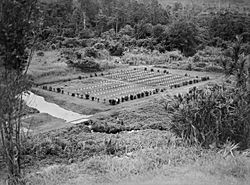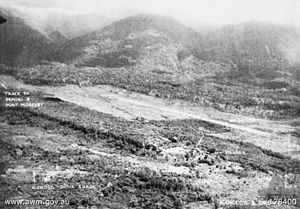Battle of Kokoda facts for kids
Quick facts for kids Battle of Kokoda |
|||||||
|---|---|---|---|---|---|---|---|
| Part of the Second World War, Pacific War | |||||||
 War cemetery at Kokoda, April 1944 |
|||||||
|
|||||||
| Belligerents | |||||||
| Commanders and leaders | |||||||
| William T. Owen Allan Cameron |
Hatsuo Tsukamoto Tetsuo Ogawa |
||||||
| Units involved | |||||||
|
Maroubra Force
|
South Seas Detachment
|
||||||
| Strength | |||||||
| 1st battle: 130–148 2nd battle: 430 |
1st battle: 200 2nd battle: 660 |
||||||
| Casualties and losses | |||||||
| 30 killed 23 wounded |
33 killed 70 wounded |
||||||
The Battle of Kokoda was actually two fights that happened in July and August 1942. It was a key part of the Kokoda Track campaign during the Second World War. Australian soldiers, with help from the United States, fought against Japanese troops. These Japanese soldiers had landed near Buna and Gona in Papua in mid-July 1942. Their goal was to capture Port Moresby by marching overland.
The first fight happened on 28–29 July 1942. A small group of Australians tried to defend Kokoda village. They faced the first Japanese soldiers moving towards the Owen Stanley Range. The Australians were almost surrounded and had to retreat. The second fight took place just over a week later, from 8 to 10 August. A smaller Australian group tried to take Kokoda back. At the same time, the main Japanese force also attacked. The two sides met head-on. The Australians briefly recaptured Kokoda, but were soon forced to pull back again.
As the Kokoda Track campaign continued, the Japanese pushed the Australians back. They got very close to Port Moresby. But then, in late September and early October, the Australians started to push back. The Japanese retreated north to defend their landing spots. The Australians finally took Kokoda back in early November 1942.
Contents
Why the Battle Happened
On 21 July 1942, Japanese forces landed on the northern coast of Papua. This was part of their plan to capture Port Moresby. Port Moresby was a very important town. The Japanese wanted to cross the Owen Stanley Range using the Kokoda Track. Earlier, they had tried to attack Port Moresby by sea. But that plan failed during the Battle of the Coral Sea in May 1942.
The first Japanese soldiers landed without anyone stopping them. There were only a few Australians in the area. These Japanese troops were meant to check the path over the Owen Stanleys. The main Japanese force, called the South Seas Detachment, would arrive later.
After the Japanese landed, there were small fights. These were between the first Japanese soldiers and small groups of Australians and Papuans. These groups were mostly from the Papuan Infantry Battalion (PIB). The Japanese kept moving forward towards Port Moresby. The Australians had only a few soldiers north of Port Moresby. They tried to slow the Japanese down. This would give them time for more soldiers to arrive.
For example, Australian and PIB troops destroyed a bridge at Wairopi. This happened on 24 July. There was a short fight as the Japanese tried to cross the Kumusi River. The next day, about 100 Australians and Papuans ambushed the Japanese near Gorari. They killed two Japanese soldiers before retreating.
As more Australians arrived, they tried to make a stand near Oivi. This was led by Captain Sam Templeton. His group was from the 39th Infantry Battalion. But they were surrounded and lost many soldiers. Captain Templeton was captured and killed. The remaining Australians and Papuans went back to Deniki. There, they met more soldiers from the 39th Infantry Battalion. These new troops were getting ready to move to Kokoda. Their goal was to hold the village and its important airfield.
Kokoda village is on a flat area north of the Owen Stanley Range. It's important because it's on the northern path to Port Moresby. South of Kokoda, the track goes steeply up towards Deniki. Kokoda also has an airfield. This airfield was very important for both sides. It allowed them to fly in supplies and more soldiers. This was key for fighting in the mountains to the south or the flat lands to the north.
The Fights at Kokoda
First Battle: Holding the Village
The first battle at Kokoda happened after smaller fights. These earlier fights had forced the Australians and Papuans of Maroubra Force to fall back to Deniki. On 28 July, about 130 to 148 Australians and Papuans marched north from Deniki. They were led by Lieutenant Colonel William T. Owen. They took back Kokoda village. They had heard that the Japanese had not yet reached the village.
Most of these soldiers were from the 39th Infantry Battalion. Some were survivors from the Oivi fight. There were also men from the PIB and other units. Kokoda was hard to defend, especially for such a small group. Owen placed his soldiers north of the village. They formed a horseshoe-shaped defense. Three groups were forward, and one was back, guarding the path to Deniki. From here, the Australians tried to hold Kokoda village. They faced about 200 Japanese soldiers. These were the first parts of the 144th Infantry Regiment.
The Australian defense did not last long. On the afternoon of 28 July, the Japanese attacked. They were experienced soldiers. They moved around the sides of the Australian position. Later that afternoon, two US transport planes arrived. They were bringing more Australian soldiers. But the planes did not land. The defenders were too slow to clear the airfield. The pilots thought it was too dangerous.
As night came, the Japanese began to bother the defenders. Then, in the early hours of 29 July, they launched a full attack. They used small mortars and an artillery gun. These weapons caused injuries to the Australians. The Australians had no way to fight back against these attacks. But they fought hard with machine guns and grenades. After about an hour of close fighting, the Australians had to retreat. Their commander, Owen, was badly wounded and died. He had been moving among his soldiers to keep their spirits up. The Australians pulled back to Deniki under thick fog. Most of them arrived around sunrise on 29 July.
The Australians lost seven killed and six wounded. The Japanese lost 12 killed and 26 wounded. The Japanese commander, Ogawa, was killed in the fighting. Owen was later given a special award from the US for his bravery. The Australians had to leave behind some equipment when they retreated. The Japanese found these supplies, which helped them.
Second Battle: Trying to Recapture Kokoda
There was a short break in the fighting. Then the second battle for Kokoda happened from 8 to 10 August 1942. Both sides used this time to bring in more soldiers. Major Allan Cameron took command of the 39th Infantry Battalion. On 8 August, he led about 430 men from Deniki. He wanted to recapture Kokoda and reopen the airfield. At the same time, the Japanese force had grown to about 660 men. They also started to advance towards Deniki.
The two sides met along the main Kokoda Track. This was a surprise meeting for both. The fight went back and forth for a couple of days. The main Australian group was pushed back towards their headquarters at Deniki. Their commander, Captain Arthur Dean, was killed. The Japanese followed them, and Cameron had to quickly set up a defense for his headquarters.
Meanwhile, another Australian group took Pirivi, east of Eora Creek. This put pressure on the Japanese from behind. Another Australian group, led by Captain Noel Symington, recaptured Kokoda. They found it almost empty.
These Australian successes surprised the Japanese. But they quickly fought back. Two groups of Japanese engineers attacked the Australians at Pirivi. The Japanese commander also sent soldiers to attack the Australians at Kokoda. The Australians at Pirivi had to retreat. Symington's group held Kokoda against strong Japanese attacks. Symington tried to signal the main Australian force that they had taken the village. He also sent messengers asking for more soldiers and supplies.
The Australians at Kokoda kept fighting, hoping for help or supplies from the air. But no planes landed. Finally, they ran low on ammunition and food. Symington's group had to leave Kokoda at 7:00 pm on 10 August. They moved south through the jungle. They eventually reached Isurava on 13 August.
In this second battle, 21 Japanese were killed and 44 wounded. The Australians had similar losses: 23 killed and 17 wounded. The day after the battle, Allied planes dropped supplies over Kokoda. They didn't know the village had fallen to the Japanese. So, these supplies fell into Japanese hands. This helped the Japanese with their own supply problems. Later, Allied planes bombed the village after learning it was captured.
What Happened Next
Even though the Australians didn't hold Kokoda, their attack surprised the Japanese. It also delayed the Japanese advance on Deniki by four days. The Japanese thought the Australian force at Kokoda was much larger. This, along with news from the Battle of Guadalcanal, made the Japanese delay their push towards Port Moresby. This delay gave the Australians valuable time to get ready for the next big fight at Isurava.
Losing Kokoda meant the Australians didn't have an airfield close to the front lines. If they had held it, they could have flown in more soldiers and supplies. This might have stopped the Japanese from moving further into the mountains. However, the Japanese also couldn't use the Kokoda airfield much. They had lost many aircraft during the Battle of Guadalcanal.
The fighting continued. The Japanese kept moving south along the Kokoda Track. There were more battles around Deniki, Templeton's Crossing, Efogi, and Ioribaiwa. The Japanese got very close to Port Moresby.
In late September and early October, the situation changed. The Japanese faced problems in other battles, like Milne Bay and Guadalcanal. So, they started to defend instead of attack. The Australians then launched a careful counter-attack. They retook Kokoda without a fight on 2 November 1942. The airfield was damaged, but the Australians began fixing it. Once supplies could be flown in, it made it much easier to support the soldiers. This helped the Allied counter-attack move faster.
After Kokoda, there was heavy fighting around Oivi and Gorari. These were the last big battles of the Kokoda Track campaign. The Japanese were pushed back to their landing areas on the northern coast.
After the war, Australian military units were given a special honor for fighting at Kokoda and Deniki. This honor was called "Kokoda – Deniki." It was given to the 39th Infantry Battalion and the Pacific Islands Regiment.
Images for kids





